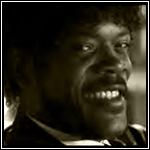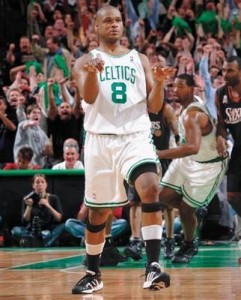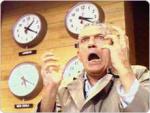Mission Impossible
No one shuts down Michael Jordan, but the champion Detroit Pistons have developed an intricate defensive system, called the Jordan Rules, that comes close to containing him
By Jack McCallum
Issue date: November 6, 1989
Sports Illustrated For as far back as he can remember, Joe Dumars has played the tough guys. "Neal Carter from Captain Shreve High in Shreveport," says Dumars, smiling at the memory of his high school days in Louisiana. "Man, I just couldn't stop that guy. I'll never forget him."
And what happened to Carter? "Lost track of him after high school," says Dumars, who attended Natchitoches Central. "But if it had been up to me, he would've gotten a scholarship somewhere."
The man that Dumars is best known for guarding these days has a slightly higher profile than Carter did. Michael Jordan is his name. Has a few moves. Can jump a little. Definite scoring threat.
Dumars is the point man, the first line in a Detroit Piston defensive scheme that possibly represents the most concentrated effort to contain one player in NBA history. The Pistons' proficiency in executing that defense has been a big factor in their success -- two appearances in the playoff finals and one championship -- in the last two seasons. "Their philosophy is to stop at nothing to stop Michael," says Doug Collins, who was fired after last season as coach of Jordan's team, the Chicago Bulls. "And, basically, they've succeeded."
"It should be the easiest defense in the league to tear apart," says Jordan, his voice reflecting the frustration he feels about the Bulls' failure to overcome the Pistons' scheme. "But we haven't done it. It's worked. They've accomplished what they wanted to accomplish."
It wasn't always that way. On the afternoon of April 3, 1988, Jordan embarrassed Detroit by scoring 59 points in a nationally televised game that Chicago won 112-110. That wasn't the first time Jordan had worn out the Pistons -- he had gone for 49, 47, 61 and 49 against them during various games in previous seasons. But after the 59-point effort, Detroit coach Chuck Daly had seen enough. "We made up our minds right then and there that Michael Jordan was not going to beat us by himself again," says Daly. "We had to commit to a total team concept to get it done."
So Daly and his assistants at the time, Ron Rothstein and Dick Versace, created a defensive game plan just for Jordan. Each Piston had specific responsibilities: Jordan has the ball on the wing, you go there, you do this; Jordan is posted up on the right box, you check him there, you watch for this, and so on. Collectively these responsibilities became known as the Jordan Rules.
Result? In the 17 games (including playoff games) between the Bulls and the Pistons since that 59-point outburst, Jordan has averaged 28.3 points, 7.6 fewer than he did in his first 19 games against Detroit. The Pistons have won 14 of those games, and in each of the last two seasons they have eliminated Chicago from the playoffs. Oh, Jordan, the NBA scoring champion the last three seasons, has had his moments against Detroit in those 17 outings -- he scored 40 in a regular-season game on April 7, 1989, and 46 in Game 3 of last spring's Eastern Conference playoffs -- but he has yet to erupt for what Versace calls "astro points."
Remember, too, that the better the competition, the better Jordan usually plays. When it comes to Detroit, there is another factor. Jordan doesn't like the Piston players -- in particular center Bill Laimbeer and power forward Rick Mahorn, now with the Philadelphia 76ers -- and the stakes are often quite high when the teams meet. Still, he can't really break loose.
In fact, the 46-point performance came when the Jordan Rules weren't in effect, Daly and his staff having called them off before the playoffs because they were concerned about the scoring of Chicago forwards Scottie Pippen and Horace Grant. But after Jordan's Game 3 performance gave the Bulls a 2-1 series lead, the Piston players, led by Isiah Thomas, urged Daly to reinstitute the rules. He did, and Detroit won the three ensuing games as Jordan struggled to score 23, 18 and 32 points.
Against the Pistons, the wide-open spaces through which Jordan normally knifes his body often close up. Getting open without the ball, which Jordan normally does by maneuvering Astaire-like through his teammates' picks, takes on the frantic character of a prison break when Detroit is the opponent. The Pistons can't spell "uncontested" -- they prefer the technique of knocking Jordan to the floor. "Sometimes I wish I could be my teammates looking at that defense," says Jordan. "It must be nice. But it isn't nice for me."
Much of the recent history of the Eastern Conference has been determined in showdowns between Detroit's D and Jordan's O. Jordan has lifted Chicago past other, more balanced, coulda-beens in the conference, like the New York Knicks, the Cleveland Cavaliers, the Atlanta Hawks and the Milwaukee Bucks. He has not, however, been able to subdue the one team that has turned guarding him into an art form.
Okay, it's not always artful. The Pistons' mean streak is a key factor in their success with Jordan. To be blunt, they treat him rudely. Shots that would result in three-point plays against other teams don't even come close when Jordan takes them against Detroit, because he is usually careeemed, not merely fouled. The Pistons have never claimed that they intimidate Jordan, but they have certainly worn him down and chipped away at his seemingly indomitable will to score.
The Pistons aren't just ornery, though. They also have talent and commitment. "Other teams could play the same way but wouldn't get the Pistons' efficiency, because they don't have the people," says Jordan. At least three Pistons are known throughout the league for their skills on D -- Dumars and forwards Dennis Rodman and John Salley -- and Thomas and guard Vinnie Johnson are smart, tough defensive players, too. Moreover, says Detroit assistant coach Brendan Suhr, "Our players believe the defense will work. That's important. If you go into this thing with anything less than a full commitment, it won't work."
Here are several other elements that help the Pistons contain Jordan:
# Not only are the 6 ft. 3 in. Dumars and the Pistons' back-up Jordan- stopper, the 6 ft. 8 in. Rodman, outstanding man-to-man defenders, but they present him with contrasting defensive styles. Dumars is basic. He gives Jordan space so that Dumars can always be in position to, above all, stop the drive, but that's not to say he plays Jordan loosely. On the contrary, he carries the message of this 1963 Little Peggy March hit every minute that he's assigned to Jordan: "I will follow him/ Follow him wherever he may go./ There isn't an ocean so. . . ." You get the picture. "Joe is strong, physical, sound," says Jordan. "He doesn't do anything spectacular, but he gets it done."
Rodman plays phone booth defense on Jordan, right up on him, inviting a drive to the hoop. While Dumars rarely even makes a swipe at Jordan's shot -- he had only six blocks last season, none on Jordan -- Rodman is tall enough and quick enough to go after the 6 ft. 6 in. Jordan's shot and get it from time to time. "Rodman's kind of a flopper (a player who constantly falls down in an effort to draw a charging call), and he gets some calls," says Jordan. "But he's got very quick feet, and he can get away with playing me that close. Sometimes."
Daly also assigns Johnson, a muscular defensive player along the lines of Dumars, and Thomas, a cagey, steal-oriented defender, to Jordan from time to time, too. "You must have that initial guy, a guy like Dumars, to accept the physical and mental challenge of playing Michael," says Collins. "If you don't, Michael will kill you, regardless of how great your principles are."
# The Pistons have big, agile and quick defenders on the weak side, i.e., on the side away from Jordan when Jordan has the ball. Rodman and Salley are two of the best. As we shall see, they must be able to confront Jordan if he gets by his defender and must be quick enough to switch over and harass the other Chicago shooters when Jordan gives up the ball. The reason that other Bulls, especially Pippen and Craig Hodges, have often missed painfully open shots is that Rodman or Salley was usually flying at them as they released the ball. Last season the weakside defenders played an important role in helping Detroit limit opposing teams to .447 shooting, second best in the league after the Utah Jazz's .434.
# The Pistons have smart defenders off the ball. Laimbeer will never make anyone's all-defensive team, but he's extremely valuable when the Jordan Rules are in effect. His specialty is clogging, which in this case is not a Scottish dance but a technique to keep Jordan from slipping through the cracks in the defense, rather like a football linebacker. Laimbeer, lead-footed but quick- witted, performs this function extremely well (so did Mahorn), and veteran backup center James Edwards isn't bad at it either.
# In Thomas the Pistons have a quick defender who knows the intricacies of the zone defense. When Detroit is playing under the Jordan Rules, Thomas often has the job of bouncing around on the perimeter, sometimes making an all-out effort to double-team Jordan but always carrying the message that he might be coming. Larry Bird plays the same role, albeit closer to the basket, for Boston. Sure, sometimes Thomas doesn't aggressively double-team the ball and should be whistled for illegal defense, but he rarely is, because he's active enough to look as if he's playing one of Jordan's teammates man-to-man.
# Detroit has offensive-minded guards who force Jordan to expend energy on defense. No, Dumars, Johnson and Thomas don't fit the big-guard profile of, say, Dale Ellis of the Seattle SuperSonics and Rolando Blackman of the Dallas Mavericks. But they're scorers, and Jordan has to play them hard. And that makes life tougher for him at the other end.
Though he will only address the subject of defending Jordan in general terms, Dumars says there are probably three or four rules to follow when Jordan has the ball and one or two when he doesn't. "The thing I keep telling myself is, Make him work as hard as he can for everything," says Dumars. "Don't give him anything uncontested. A lot of players are concerned with him dunking on them or making some kind of fantastic move. You know what? That doesn't bother me at all. That means he's worked that much harder to get something and expended that much more energy. What I don't want is for him to start pulling up and hitting easy, unspectacular jumpers.
"The key to playing him is discipline. You can't gamble on him. You must wait for him to make a move. Early in my career I used to be so hyped up when I played him that I practically faked myself out. I'd be jumping all around, reacting to everything, every head shake or pump fake. Fundamental, man-to-man defense is the only thing that will work against him. And sometimes that won't."
The Freedom of Information Act doesn't pertain here. Daly doesn't have to make the Jordan Rules public, and he won't. But, hey, this isn't molecular biology, right? Through interviews, common sense and even a few hours of film- watching, the following would seem to cover much of Detroit's game plan against Jordan.
# The guiding principle is that a defender is never left to guard Jordan unaided. Jordan's position on the floor dictates whether the Pistons trap him with a second defender or have the second defender play "help and recover" (that is, run at Jordan to stop his dribble, but then scramble back to his own man; Salley is a master at this ploy). The closer Jordan is to the basket, the more the Pistons go with the trap. When he is above the sideline hash mark (28 feet from the baseline), they usually play help and recover.
# Even when Jordan is far from the basket, perhaps bringing up the ball as a point guard on a wide-open floor, Detroit runs a second player at him, someone like Salley or Rodman. This reduces the amount of open court that he has to work with and often forces him to give up the ball to a teammate. The Pistons always want someone else to handle the ball. Not sometimes. Always.
# When Jordan has the ball on the wing, the Detroit player guarding him forces him toward defensive help. Most often that means turning Jordan to the right when he's on the left side of the floor and to the left when he's on the right side.
# If Jordan happens to get isolated with one man and is in a potential scoring position, the Piston defender will try to force him to go left. They think he makes a stronger, more explosive move to his right. So does Jordan.
# When Jordan tries to run a pick-and-roll, Detroit traps him. That means that two men, the one guarding Jordan and the one guarding the Bull setting the pick, run at him. The Pistons do this with remarkable efficiency, partly because that second defender is usually the 6 ft. 11 in. Salley or the 6 ft. 11 in. Laimbeer. The tall trappers make it almost impossible for Jordan to deliver the ball to a teammate rolling toward the basket, and their aggressive charge toward Jordan usually forces him to retreat.
# When Jordan posts up near the basket, Detroit typically puts three men on him, with Dumars most often behind him, using his strong hips and legs to "body" Jordan away from the basket. When the entry pass comes in from the point guard, Thomas leaves that guard and double-teams Jordan. If that means the point guard is free, so be it. Meanwhile, another defender, perhaps Laimbeer or Salley, will have come over and planted himself in the lane, maybe on the baseline side, maybe toward the middle. Dumars will then turn Jordan toward that help. Jordan loves the baseline. "Even though there's less room down there, I can be more creative," he says. But by and large, the Pistons take it away from him.
# When Jordan comes off a screen set near the baseline -- his most frequent maneuver when he's playing shooting guard -- a host of Jordan Rules come into play. Dumars must follow him around the screen -- no matter if he has to go into the bleachers -- to prevent Jordan from making a backdoor cut and receiving an alley-oop pass for an almost certain dunk. The Piston -- usually Laimbeer -- guarding the Bull setting the pick will step out to make Jordan receive the ball farther from the basket. In addition -- and this is important -- that man will guard against Jordan's making a "tight curl" off the top of the screen and suddenly looping back into the middle to take a short pass on the dead run, a circumstance that is almost always disastrous for the defense.
In most cases Jordan will have to step back and take the pass on the wing. Then Thomas will come over, creating a double team, and the process begins all over again. If Jordan puts the ball on the floor, at least two players stay on him, pushing him toward even more help. If he passes, the weakside defenders adjust to play two Pistons against four Bulls or one against three. As long as Jordan is out of the picture, they love those odds.
What's more, the Pistons make it even harder on Jordan and Chicago's coaches by varying the timing of their traps and help-and-recover maneuvers. Sometimes they come as soon as Jordan touches the ball, other times not until he has made his first dribble, other times not until he has begun to penetrate. For Jordan, facing Detroit is a nonstop physical and mental challenge. Think of it from Jordan's standpoint: This isn't a cat-and-mouse game; it is a cats-and- mouse game.
So Chicago knows that the Pistons have their million-dollar baby wrapped up in chains. What can the Bulls do about it this season? On paper, anyway, it seems simple: Hope that Hodges's jump shot is more accurate in pressure situations than it was last year. Hope that rookie point guard B.J. Armstrong of Iowa is good enough to start -- thereby enabling Jordan to return to shooting guard -- and that he can exploit the nooks and crannies in the Detroit defense. Hope that another rookie, 6 ft. 11 in. Stacey King of Oklahoma, becomes enough of a scoring threat inside to make the Pistons pay for enforcing their rules; the current pivotman, Bill Cartwright, is not.
"As Michael's supporting cast gets better, this defense is going to be tougher to play," says Dumars. "Jordan is the constant. We know what he can do. It's what everybody else does that matters." So far, that hasn't been enough.




 Reply With Quote
Reply With Quote









Bookmarks